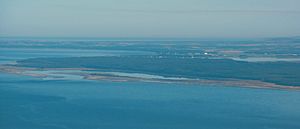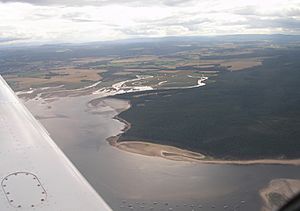Culbin Sands, Forest and Findhorn Bay facts for kids
Culbin Sands, Forest and Findhorn Bay is a really big and special area in Moray, Scotland. It stretches from near the town of Nairn all the way to the village of Findhorn and its bay. This whole area is super important for animals and plants, so it's protected by law as a SSSI. That means it's a place with special wildlife or geology. In Gaelic, Culbin Sands is called Bar Inbhir Èireann.
Contents
Discovering Culbin Forest
This huge forest is mostly owned by the Forestry Commission, which manages forests in the UK. It has many big paths and smaller tracks for exploring. Some parts off the paths are very dense and hard to walk through. Many people start their walks at Wellhill Car Park and head towards the beach.
As you walk, you might spot some interesting stone pillars with messages. There's even a small plaque on one tree, celebrating its planting by Prince Charles (who is now King Charles III). The forest is mostly made up of tall pine trees. But it also has open, sandy spots where young trees have just been planted. The grassy areas are perfect for butterflies to flutter around. You'll also find several ponds, which are like little water stops for local animals.
For an amazing view, you can climb Hill 99. It's a tall wooden structure that blends in with the treetops. While the animals in the forest can be shy, you'll definitely hear birds singing all around you!
Special Animals in Culbin Forest
Culbin Forest is home to some unique birds, like the crested tit, which builds its nest here. It's also a very important place for a rare insect called the Kentish glory moth.
These moths love the way the Forestry Commission works. When trees are cut down, it creates open spaces where young birch trees can grow. These small birch trees, especially those under three metres tall, are the favorite food for the moth's caterpillars. So, the moths follow the tree-cutting activity around the forest. You can often see the adult moths flying around in April and May.
Exploring Culbin Sands
Today, "Culbin Sands" usually means a beautiful beach. But a long time ago, it was a huge area of loose sand dunes, which is now where Culbin Forest stands. Back then, this dune system was the biggest in Britain!
This long, clean beach is owned by the RSPB, a group that protects birds. It's a fantastic place for birds to live. You can see Eurasian oystercatchers, Eurasian curlews, common redshanks, and many other types of birds here. The beach is a mix of sand and long grass, but it gets muddier as you go further west. Lots of natural driftwood washes up on the sands.
Three sand spits (long, narrow pieces of land that stick out into the water) create a large salty marsh called 'The Gut'. The biggest spit, known as 'The Bar', is the largest one in all of Scotland!
Near Nairn, the beach is a winter home for a group of pale-bellied brant geese. This is one of only two places in Scotland where these geese, which come all the way from Svalbard, spend the winter.
In the late 1800s, a special bird called Pallas's sandgrouse nested on these dunes. This was the only time this bird has ever been recorded breeding in Scotland.
The Shifting Sands of Culbin
The Culbin Sands used to be famous for moving around a lot, even burying homes! This happened because people removed a plant called marram grass from the dunes to use for roofing. The roots of this grass are super important because they help hold the sand together.
To stop the sand from shifting, the Forestry Commission started planting bushes and then trees in the area. This helped to make the dunes stable, and that's how Culbin Forest began to grow.
Discovering Findhorn Bay
Findhorn Bay isn't a true bay. It's actually a large area of water that changes with the tides, like a big basin. It's surrounded by the villages of Kinloss and Findhorn on one side, and Culbin Forest on the other. The River Findhorn and the Muckle Burn flow into it.
Across from Findhorn Village, the beach is home to a mixed group of grey and common seals. You can also spot common eider ducks swimming offshore and European herring gulls flying around. On the southern side of the bay, there's a slightly salty pool where wading birds like the greenshank often visit during their migration seasons.
In winter, the bay becomes a resting place for at least 10,000 pink-footed geese! These geese gather here in huge numbers.
Fun Activities in Findhorn Bay
The deepest part of the bay is the channel that leads out to the Moray Firth, where it can be up to 10 metres deep. But most of the bay is quite shallow, usually around 2 metres deep. Because it's safe and doesn't have strong waves, Findhorn Bay is a popular spot for people who enjoy sailing and windsurfing.
A Look Back at History
There used to be a village located northeast of Culbin Forest, but its exact spot is now unknown. Stories from the past said the village was buried by sandstorms in 1694. However, old news records from that time don't mention this. It seems the sandstorm stories are more like old folk tales.
What historical records (kept at the Local Heritage Centre in Elgin, Moray) do show is that the village of Culbin cut down too many trees in the Culbin Forest. This made the land between the village and the mainland unstable. Because of this, the sea was able to wear away the land, and eventually, the village sank into the water.
Something similar happened to the village of Findhorn, which used to stretch further out into the sea than it does today.
After the village of Culbin caused so much deforestation, the Culbin Sands lay empty until the 1920s. That's when the Forestry Commission started planting pine trees there. This huge tree-planting effort took about 40 years to complete!



